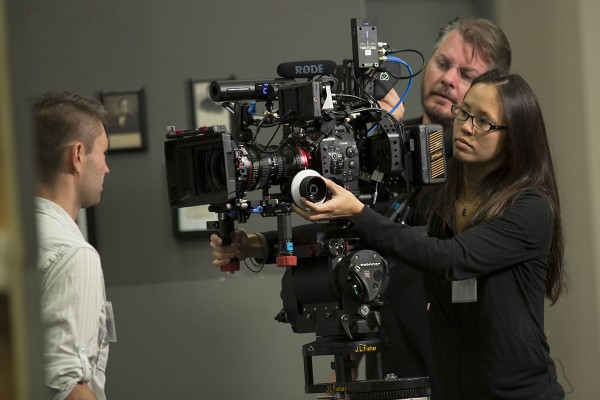By: Christopher Holder
Picture Courtesy of: Daniel Sievert
There’s nothing quite like high-quality audio to give your production a professional sheen. And there’s no time like the present — get the sound during the shoot and capture the emotion and atmosphere of the moment. Which is why we’ll kick off this series with production mics — miniature mics this time around, boom mics next issue, then on to studio/post production mics.
Once upon a time, a shotgun mic attached to a boom was the only way to fly (and is often still preferable). But now, a good miniature mic system is a wonderful weapon to have in your armoury without it costing an arm or leg.
MINIATURE MIC
Let’s get our terminology down first. What I’m generically calling a miniature mic has traditionally been dubbed a ‘lavalier’ mic — but more often you’ll hear it called a ‘lav’. Many manufacturers produce them — Rode, Shure, DPA, Sennheiser, Countryman, and others — and they all aim for the same thing: to be as small as possible and provide as natural and as even a frequency response as possible. These microphones generally exhibit an omnidirectional pickup pattern (which means it doesn’t matter which way you point the mic, it’ll behave in the same way, capturing sound from all directions).
IN THE HAIRLINE
Many lav mics ship with a baby-afro-style windshield. Take the windshield off and you can quite easily conceal the mic in the hair near the actor’s temple or forehead. Take a listen to the results in your headphones and you’ll quickly learn that you don’t need to have the mic ‘in front’ of the mouth to get a good natural response.
Messing up Wardrobe or Makeup’s hard work on set as you fiddle about with the wig or hairdo won’t make you popular. So liaise with the other departments to get the best results for everyone.
UNDER THE COLLAR
If it’s not possible to place the lav in the hairline, concealing it under the collar can produce excellent results. Again, remove the mic’s windshield and use ‘dead cat’ fake fur material (or moleskin) over the capsule and tape it down to the inside of the collar, out of sight. Potentially, your take will be spoilt by the sound of the mic capsule rubbing against the costume, so the dead cat material is important.
CLIP IT ON
If the scene allows for the lav to be in shot — reporter style — then you’ve got it easy. Clip the mic to the talent’s lapel (about 25cm below the mouth), get your levels right and away you go.
CONCEAL IT
Being so tiny, your miniature mic can hide anywhere— not just on the actor’s person. Certain shots will allow you to conceal your mic in a pot plant, in some other prop or in the scenery. It’s a great, economical way of getting two actors to share the one mic in a scene. Obviously it’s a no-go if the actors are moving about, but in a scene where the protagonists are talking over a dinner for two, for example, you can easily conceal a lav in the flower arrangement.
PLUGGING IN
What we haven’t discussed is what the miniature microphone plugs into. In normal circumstances the lav needs to plug into a wireless transmitter. These transmitter packs vary in size from manufacturer to manufacturer but Shure, for example, has ENG (electronic news gathering) kits with packs that are not much bigger than a couple of AA batteries. Of course, every transmitter needs a receiver to work, and you’ll have another wireless receiver pack that will plug into your audio recorder or into your camera.
SMART(PHONE) SOLUTION
There’s a recent alternative to using wireless and that’s to plug straight into your audio recorder. But given the size and weight of even the most low-profile recorder like a Zoom, it’s not practical for the actor to have that strapped to their person. Rode Microphones has identified the smartphone as a neat alternative. In fact, it’s developed an iOS app (Rode Rec). The idea is to set the talent up with a lav and put the iPhone or iPod Touch in their pocket. If you already have the iDevice then this approach will save you quite a bit on the wireless kit.
WIRED
There’s no reason why you can’t run your lav wired into a recorder. You’ll need some kind of adaptor that will turn your miniature mic connection into a balanced XLR connector, but they’re readily available. Obviously care needs to be taken when running the cable and it’s not going to work if mobility is required.
BRING THE NOISE
In a world of unwanted production noise, the omnidirectional response of lavalier mics may mean they’re unworkable in certain situations. I’ll go through the directional characteristics of a boom mic next issue, but an omnidirectional lav will pick up absolutely everything within its orbit – there is absolutely no rejection of audio ‘behind’ it.
Saying that, if you can get <close enough> to your actor’s mouth then dialogue is likely to be the loudest audio signal in your bud mic’s vicinity, and you’ll find that unwanted noise will be reduced because of the mic’s proximity and the resulting gain setting you have because of that proximity. In other words: with the mic nice and close, the gain knob is set low; resulting in the flight path/lawn mower noise being comparatively low.
SMALL-TIME ADVANTAGES
The advantages of lavalier mics are many: you don’t have to worry about the boom mic creeping into shot; you don’t need a dedicated sound recordist/boom operator to handle the boom mic; and the sound you get from a properly positioned lav can be excellent — intimate, present, with a good consistent level.
That said, miniature mics aren’t for everyone or for everything. Having more than a couple of lavs on set with their attendant wireless rigs makes for a comparatively high-maintenance setup. Having two actors talking at close quarters, each with lavs, will mean there will be ‘bleed’ (where you’re capturing both actors in both mics) and possibly some phase problems (where certain frequencies will cancel or be more prominent due to audio signals combining in less than perfect ways). In those circumstances, a boom mic would be preferable.
$64,000 QUESTION
So when should you use a lav, and when should you use a shotgun mic on a boom pole? It’s down to what sounds best. A shotgun mic manned by an expert boom pole operator is very hard to beat. The quality of the dialogue is awesome. But where you simply can’t get close enough with the boom, then your lav will provide superior results.
As I mentioned earlier, when you’re capturing the dialogue of more than one person in shot, then a shotgun on a boom will be a safer bet.
And finally, if you’re struggling with high ambient noise then go with the tighter, more controlled pickup pattern of a shotgun mic.








